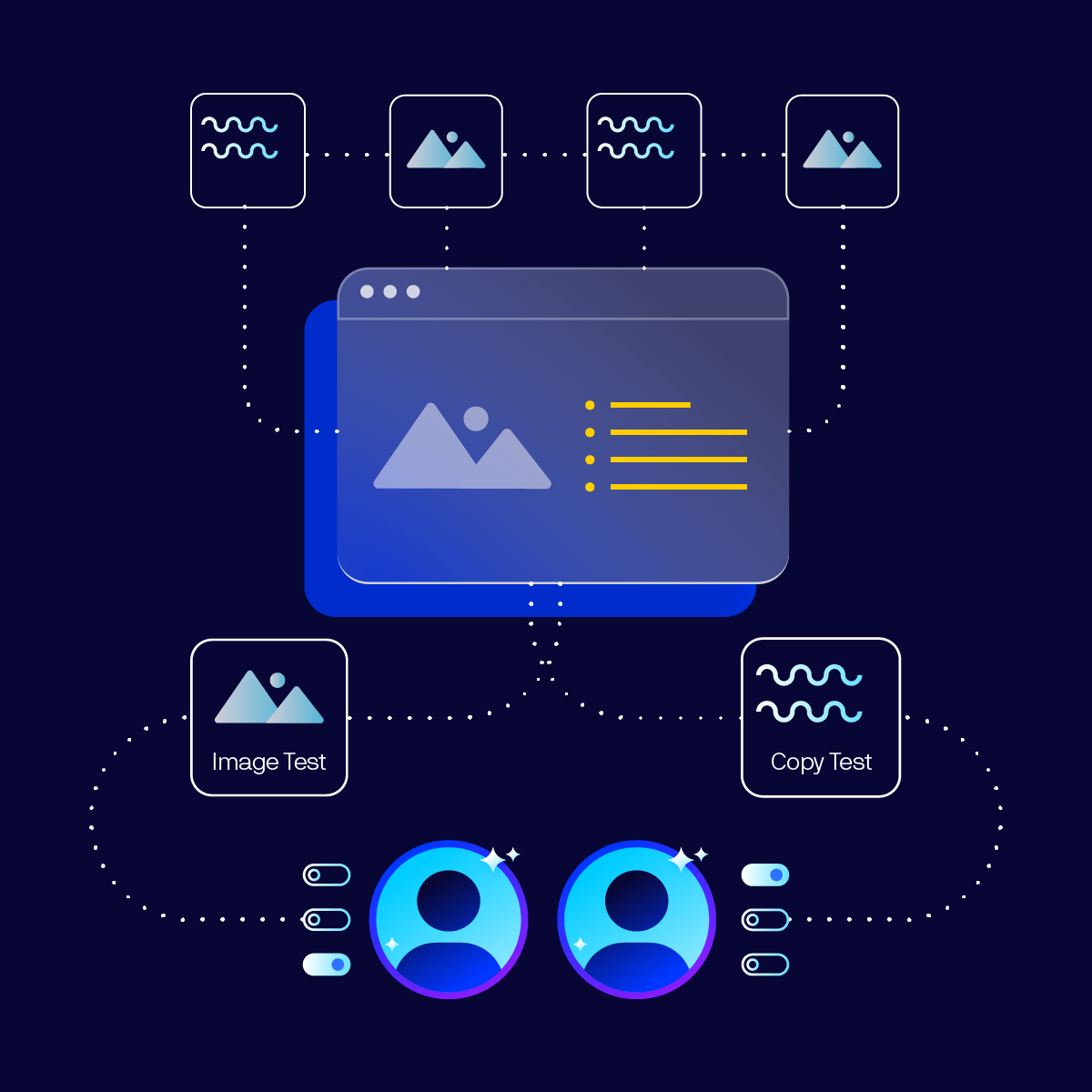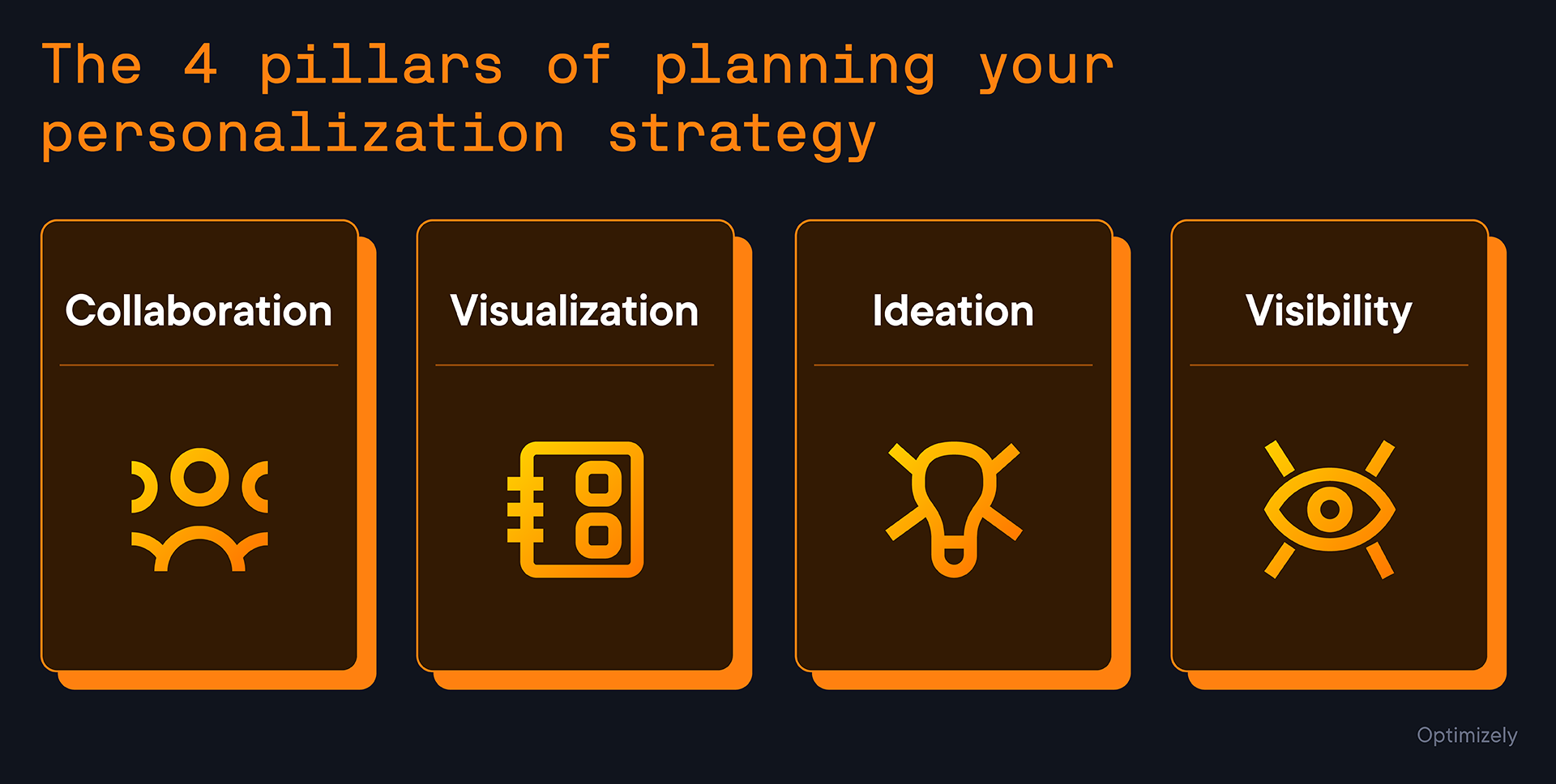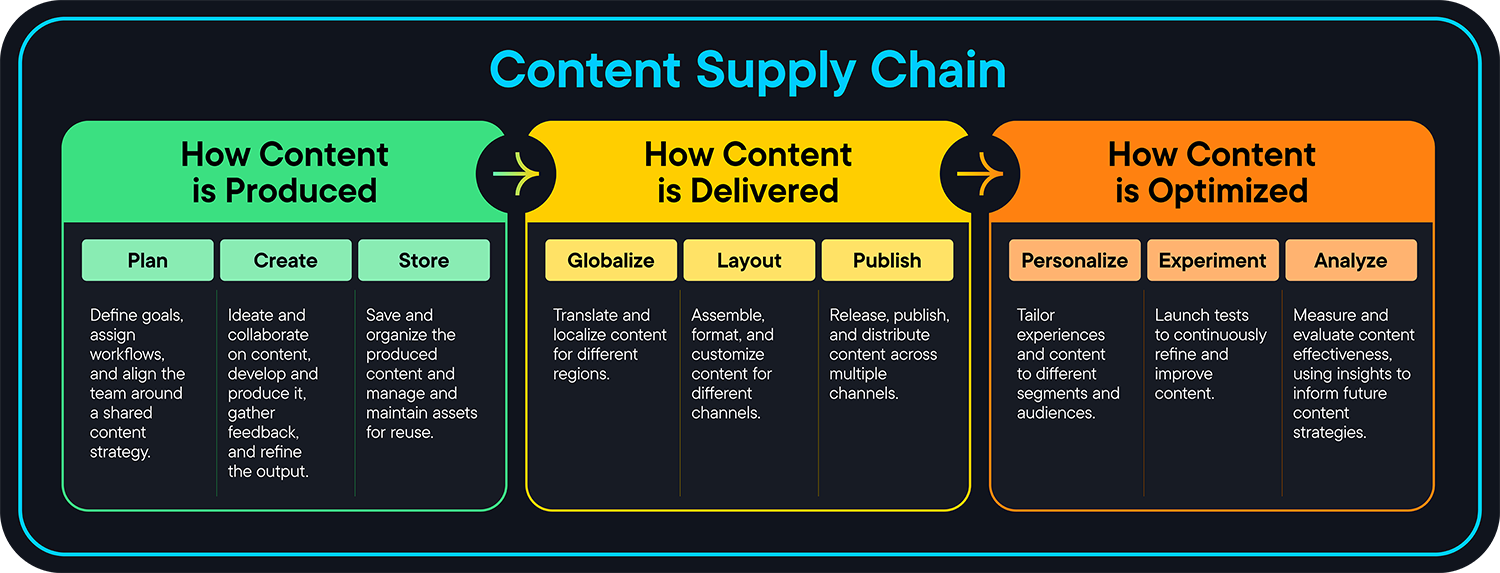Wenn wir über Personalisierungsstrategien nachdenken, denken wir in der Regel daran, wie wir das Erlebnis unserer Kunden verbessern können, indem wir Websites und Apps auf spezifische Bedürfnisse zuschneiden.
Aber was Vermarkter wirklich beunruhigt, ist die Beziehung zwischen Personalisierung und Inhalten - insbesondere die Frage, wie die Erstellung von Inhalten skaliert werden kann, um den Ertrag der Personalisierungsmaßnahmen zu maximieren.
Wir können Sie mit so viel Unternehmensjargon bewerfen, dass Sie damit einen Equinox-Pool füllen können. Die Quintessenz ist: Je mehr Inhalte Sie zur Verfügung haben, desto größer sind die Chancen, dass Sie relevante Inhalte finden. ![]()
Die Skalierung der Inhaltserstellung ist einfacher als Sie denken. Mit der richtigen Content Marketing Platform können Sie Arbeitsabläufe erleichtern, die den Zeitaufwand für die Erstellung von Inhalten drastisch reduzieren, die Zusammenarbeit bei der Ideenfindung und Strategie erleichtern, die Veröffentlichung vereinfachen und sogar KI für die Erstellung von Inhalten nutzen.
Welcher Zusammenhang besteht zwischen Inhalten und Personalisierung?
Bei der Personalisierung treffen Inhalte und Daten aufeinander.

Wenn Sie Daten von Ihren Kunden sammeln und mehr über sie erfahren, können Sie besser feststellen, was sie zu welchem Zeitpunkt konsumieren möchten.
Einige Beispiele hierfür sind:
- Für E-Commerce-Marken kann dies so einfach sein wie Produktempfehlungen auf der Grundlage von Echtzeit-Verhalten und historischen Kaufdaten.
- Bei Reiseveranstaltern, Banken, Automobilherstellern oder anderen Konsumgüterherstellern können die Inhalte über die konsumierbaren Assets hinausgehen und maßgeschneiderte Seiten mit maßgeschneiderten Angeboten, Gutscheinen, Verkäufen, Plänen und verschiedenen Engagements umfassen.
- Kunden, die Ihre Seiten mit Fallstudien und Kunden-Cases besuchen, sind wahrscheinlich näher an der Kaufphase. Hier sollten Sie das Erlebnis im Web optimieren, um sie dazu zu bringen, mit Ihrem Team in Kontakt zu treten.
- Benutzer, die Blog-Beiträge lesen, sollten zu längeren oder umfangreicheren Inhalten wie längeren Videos oder Whitepapers gelenkt werden, da sie sich eher in einer Erkundungs- oder Entdeckungsphase befinden.
Sobald Sie Daten zur Bereitstellung von Inhalten verwendet haben, können Sie analysieren, wie Ihre Kunden diese Inhalte konsumieren und mit ihnen interagieren, um noch mehr Daten zu sammeln.
Sehen Sie, wie das funktioniert?
Wenn Sie jetzt mit dem Kopf nicken und sagen: "Ja! Wir brauchen Daten über unsere Nutzer, um sicherzustellen, dass sie die richtigen Inhalte zur richtigen Zeit erhalten, und gleichzeitig sehen wir uns an, was sie tun, nachdem sie diese Inhalte erhalten haben, um ihr Kundenprofil noch weiter auszubauen, damit wir mehr über sie erfahren und den Kreislauf in Gang halten können", dann haben Sie es verstanden!
Einfach genug, oder?
Nun, nicht so schnell.
Wahrscheinlich sagen Sie sich auch: "Moment mal, das ist doch ganz einfach, wenn ich ein Tool habe, mit dem ich unsere Inhalte verwalten kann, und eine Customer Data Platform, und ein Tool zur Personalisierung, und ein Tool zum Experimentieren, und ein Tool, das Inhalte für mich schreibt, und ein Tool, das meinen Laptop in eine French Press verwandelt, und ein Tool, das..."
Aber was ist, wenn Sie das alles nicht haben? Sie brauchen mindestens eine Content Marketing Platform (CMP), ein Content Management System (CMS), eine Customer Data Platform (CDP), eine Experimentier-Plattform, eine Personalisierungs-Plattform und einige andere abhängige Tools, damit das alles reibungslos funktioniert.
[An diesem Punkt wissen Sie wahrscheinlich schon, dass wir Ihnen unsere Lösung Optimizely One vorstellen werden, die all diese Funktionen in einem einzigen Marketing Operation System zusammenfasst. [/Pflichtbewusstes Verkaufsgespräch]
Sie haben noch kein Interesse an Optimizely One? Das ist völlig in Ordnung. Sie machen das schon. (Nein, im Ernst, völlig in Ordnung!)
Hier erfahren Sie, wie Sie die Erstellung von Inhalten mit dem skalieren können, was Sie wahrscheinlich schon haben.
Inhalte liefern hyper-personalisierte Erlebnisse
Hyper-Personalisierung von Inhalten bedeutet eines von zwei Dingen:
- Sie benötigen eine riesige Bibliothek mit Inhalten, die eine Vielzahl von Themenbereichen abdecken
- Sie haben einen extrem engen, spezifischen Kundenstamm
In jedem Fall müssen Sie genau wissen, was Ihre Kunden sehen wollen, wann sie es sehen wollen und was sie tun sollen, wenn sie es sehen.
Das bringt uns also zu Schritt 1...
Daten
Brauchen Sie Daten, um Inhalte zu skalieren? Nicht unbedingt. Wenn Sie einen extrem fokussierten Kundenstamm haben und Ihre Hausaufgaben bezüglich Ihrer Personas gemacht haben, können Sie Inhalte durchaus skalieren.
Aber eine solide Dateninfrastruktur wird Ihre Strategie zur Erstellung von Inhalten in Echtzeit und auf eine Art und Weise, die Ihnen vielleicht gar nicht bewusst ist, aufladen (Achtung: Unternehmensjargon!).
Eine der effizientesten Möglichkeiten, datengesteuerte Inhalte zu erstellen, ist die Integration einer Customer Data Platform (CDP).
Für Unternehmen, die digital reif sind (oder dies anstreben), ist eine CDP ein unverzichtbarer Bestandteil Ihres Martech-Stacks.
Angesichts der großen Menge an Daten, die an den verschiedenen Berührungspunkten innerhalb und außerhalb des Unternehmens gesammelt werden, ist es wichtig, dass Sie diese Daten so effizient wie möglich nutzen können.
Und während Sie vielleicht denken, dass das so einfach ist wie das Aufräumen Ihres Kabelsalats, den Sie schon ewig "für alle Fälle" aufbewahrt haben, ist die Wahrheit, dass eine leistungsstarke CDP genau das möglich macht.
CDPs ermöglichen Ihnen:
- Ihre Daten zu vereinheitlichen
- das Kundenverhalten zu verstehen
- Integrationen und kanalübergreifende Aktivierungen zu erleichtern
- Kundeninteraktionen vorhersagen
- den Customer Lifetime Value (CLV) zu steigern
Content Marketing Platforms (CMP)
Jeder, der Inhalte in irgendeiner Form oder Größe erstellt, weiß, wie mühsam es sein kann, den Überblick zu behalten: Benachrichtigungen werden verpasst, das WiFi ist miserabel, Strategien werden strategisch neu ausgerichtet, niemand weiß, wo etwas gespeichert ist, jemand hat diesen Artikel bereits vor 3 Jahren geschrieben, es gibt zu viele Köche in der Küche, es war der Tag, an dem Sie Ihren Hund mit zur Arbeit bringen, usw.
Es wird immer eine Herausforderung sein, Menschen zusammenzubringen, egal in welcher Funktion, und die Erstellung von Inhalten ist da keine Ausnahme. Bevor Sie also etwas unternehmen, müssen Sie sich auf einen gemeinsamen Arbeitsbereich einigen, der eine funktionsübergreifende Planung, Zusammenarbeit, Ausführung und Messung ermöglicht.
Wenn Sie Ihre Content Marketing Planungslösung zusammenstellen, sollten Sie die 4 Säulen der Planung Ihrer Personalisierungsstrategie berücksichtigen, um die Effizienz des Workflows zu maximieren:

- Collaboration - Die Skalierung der Inhaltserstellung, insbesondere mit dem Ziel, Ihren Kunden personalisierte Erlebnisse zu bieten, erfordert eine zentralisierte Lösung für die Zusammenarbeit.
- Visualisierung - Marketingexperten haben eine ganz andere Art, Arbeitsabläufe zu visualisieren als Ingenieure und Product Manager. Stellen Sie sicher, dass Sie den Teammitgliedern eine flexible Art und Weise bieten, den Überblick über ihre Arbeit zu behalten, die eher ihren eigenen Arbeitsabläufen entspricht.
- Ideenfindung - Ständige Iterationen, Feedback und Experimentieren sind ein Muss für jede Content-Strategie. Wenn Sie Daten sammeln, wird sich auch Ihre Personalisierungsstrategie ändern, so dass ein einheitlicher Arbeitsbereich zur ständigen Iteration von entscheidender Bedeutung ist.
- Sichtbarkeit - Die Speicherung von Assets, der Zugriff auf Kommentare und Threads sowie Feedback-Kanäle sind nicht nur für Ihr internes Team wichtig, sondern auch für alle Stakeholder, die ein Interesse an der Markteinführungsstrategie (GTM) haben.
Skalierung der Inhaltserstellung
Wenn es um die Skalierung der Inhaltserstellung geht, müssen Content-Teams mehrere Hürden überwinden:
- Was soll erstellt werden und für wen erstellen wir es?
- Haben wir genügend Ressourcen?
- Woher wissen wir, dass wir diese Inhalte erstellen sollten?
- Wie können wir sicherstellen, dass wir diesen Prozess immer und immer wieder wiederholen können?
Lassen Sie uns diese Fragen der Reihe nach beantworten;
Was Sie erstellen und für wen Sie es erstellen
Was Sie erstellen und für wen Sie es erstellen, hängt fast ausschließlich von Ihrem Kundenlebenszyklus und Ihren Zielen ab.
Versuchen Sie, ein neues Produkt bekannt zu machen, oder versuchen Sie, bestehenden Kunden neue Funktionen schmackhaft zu machen?
Wenn Sie ein neues Produkt bekannt machen wollen, sollten Sie sich auf leicht verdauliche, visuell ansprechende Inhalte wie Landing Pages, Kurzvideos und SEO-gesteuerte Blog-Inhalte konzentrieren.
Wenn Sie versuchen, Upselling bei bestehenden Kunden zu betreiben oder Kunden zu gewinnen, die sich in der letzten Phase des Kaufzyklus befinden, sollten Sie sich auf längerfristige Inhalte wie White Paper, Webinare, Nurture-Kampagnen und Gated Content konzentrieren.
Ermitteln Sie zunächst die Schwachstellen in Ihrem Kundenlebenszyklus und beginnen Sie mit dem Targeting dieser Bereiche mit der richtigen Art von Inhalten. Ein datengesteuerter Ansatz mit einer effektiven CDP und einer Experimentierplattform ermöglicht es Ihnen, Wendepunkte zu testen, die Nutzer entweder auf der Site halten oder sie vertreiben.

Haben wir genug Ressourcen?
Wahrscheinlich nicht.
Aber im Ernst: Sie sind wahrscheinlich schon daran gewöhnt, mit so wenig Mitteln wie möglich so viel wie möglich zu erreichen. Aber das bedeutet nicht, dass alles vom Tisch ist.
Wenn Sie keine Redakteure haben, die informative Assets erstellen, können Sie KI nutzen, um die schwere Arbeit für Sie zu erledigen. Erinnern Sie sich noch daran, als Content Marketing-Experten dachten, KI würde ihnen die Arbeit abnehmen? Es hat sich herausgestellt, dass nichts weiter von der Wahrheit entfernt sein könnte. Content Marketing-Anwender, die keine KI einsetzen, fallen hinter diejenigen zurück, die sie einsetzen.
Wenn Sie kein großes Videobudget zur Verfügung haben, sollten Sie Screenshots, Produktdemos oder sogar Interviews mit geringem Produktionswert erstellen, die aber dennoch eine Fülle von Informationen bieten.
Sie dürfen nicht vergessen, dass viele Ressourcen durch schlechte Planung verschwendet werden und komplizierte Arbeitsabläufe zu Engpässen führen.
Wie bei den meisten Techniken kommt es nicht darauf an, was Sie verwenden, sondern wie Sie es verwenden.
Woher wissen wir, dass es das ist, was wir schaffen sollten?
Das ist eine gute Frage und der Grund, warum vernetzte Tools und Arbeitsabläufe so wichtig sind.
Wenn Ihre Personalisierungsengine auf Hochtouren läuft und Sie ständig experimentieren, können Sie sich auf einen datengesteuerten Ansatz verlassen, um Ihre Strategie zu entwickeln.
Es gibt keinen Grund, sich im Jahr 2024 auf Intuition und Vermutungen zu verlassen. Kunden, die mit Ihrer Site oder App interagieren, werden so detaillierte Spuren hinterlassen, dass Sie mit Sicherheit feststellen können, was funktioniert und was nicht.
Analysieren Sie, was Ihren Kunden durch Ihre Personalisierung geboten wird. Stellen Sie fest, dass die meisten der gleichen Inhalte immer wieder auftauchen? Vielleicht ist es an der Zeit, neue Wege zu gehen und ergänzende Beiträge zu erstellen, um die Vielfalt der Inhalte zu erhöhen.
Wie können wir sicherstellen, dass wir diesen Prozess immer wieder wiederholen können?
Noch einmal: Arbeitsabläufe und Planung.
Sie beginnen, ein Thema zu erkennen...
Die meisten Vermarkter stolpern bei der Skalierung von Inhalten, weil sie sich zu sehr auf den Aspekt der Erstellung und zu wenig auf die Arbeitsabläufe konzentrieren.
Was Marketingteams am meisten ausbremst, ist nicht ein Mangel an Autoren, ein Mangel an Ressourcen oder ein Mangel an Willen... es ist ein Mangel an Planung, Tests und Iteration.
Jeder kann ChatGPT veranlassen, innerhalb eines Wimpernschlags 1.000 Artikel zu schreiben. Jeder kann einer Agentur genug Geld geben, um visuelle Assets in Massen zu liefern.
Fazit
Personalisierung ist die Zukunft des Marketings und wir leben in einer Zeit, in der die Erwartungen an einzigartige 1:1-Erlebnisse steigen. Um diese Erlebnisse bieten zu können, ist eine umfassende Bibliothek von Inhalten unabdingbar.
Die Vermarkter machen sich zunehmend Gedanken darüber, wie sie so viele Inhalte erstellen können. Sie sind immer noch misstrauisch, was die Abhängigkeit von KI und die möglichen Auswirkungen unpersönlicher, fader Inhalte angeht, aber sie wissen auch, wie ressourcenintensiv es ist, ohne sie zu arbeiten.
Was wir damit sagen wollen? Sie können KI im Tandem mit Ihrer von Menschen betriebenen Content-Strategie einsetzen.
Und wenn Sie das mit ausgefeilten Arbeitsabläufen, einer exquisiten Planung und den richtigen Tools kombinieren, die harmonisch zusammenarbeiten, wird die Skalierung weniger schwierig.
- Zuletzt geändert: 06.02.2025 17:44:13
